Things To Do In Normandy
- Visit A Normandy Museum
- Sample Some Normandy Cider
- Visit Mont Saint Michel
- Spend Time At A Normandy Beach
- Walk In William The Conqueror’s Footsteps
- Free Things To Do In Normandy
- Enjoy Some Family-Friendly Fun Activities
- Take A Day Trip From Normandy
- Visit A Normandy Château
- Discover The Normandy Landing Beaches
1. Visit A Normandy Museum

Perhaps one of the best known museums in Normandy is found in Bayeux. The Bayeux Tapestry Museum spans three floors allowing visitors to learn more about this historic artefact. Although called a tapestry, it’s actually an embroidery and tells the story of the events leading up to the Battle of Hastings. The key characters are William the Conqueror and Harold II who was the king of England. The first scene on the tapestry is from 1064 and the last one is of Harold’s death in 1066. Each of the intricately embroidered panels focuses on a key part of the reasons and preparations for the invasion, crossing the channel and the battle.
The tapestry’s fragility means that it’s protected by a glass case in an exhibition room with dimmed lighting. Your ticket also gives you an audio guide which you listen to as you walk past each scene. There are 58 scenes which measure 70 meters in total. You will spend around under 15 minutes in this part of the museum. Once you’ve seen the tapestry there are a further two floors of the museum to explore. On the middle floor is a huge room full of static and interactive exhibits suitable for both children and adults.
The top floor comprises a cinema room and a 2D facsimile of the tapestry. Having learned more about the embroidery you can now really look at the details thanks to the full size printed exhibition boards. The cinema shows the film in English or French with each showing alternating between the two languages. The video below is an animated version of the tapestry.

Directions
The museum is called Le Musée de la Tapisserie de Bayeux. You can head for the centre of the city, park and then walk to the museum. The address is 13 bis rue de Nesmond, 14400 Bayeux. Their phone number is +33 (0)2 31 51 25 50. If you are travelling from Normandy Gite Holidays, you’ll take the D51 and D28 to Saint-Lô. The D972 avoids going through the centre of Saint-Lô and leads to the D572. The D572 will take you directly to Bayeux.

Notes
Parking
There’s free parking on the D572 as you approach Bayeux. It’s on the opposite site of the road so you will need to go round the Ornano roundabout (rondpoint d’Ornano) to access it. Alternatively, if you are visiting the Battle of Normandy Museum, you can park here. The museum is on Boulevard Fabian Ware and it’s a 5 – 10 minute walk to the tapestry. Rue Tardiff has a small free car park. Paid parking close by is either on Rue aux Coqs or at the Parc Michel Ornano.
Admission Times
The Museum is open from February to December with a short break over the Christmas holidays. It is closed in January. From March to October it’s open from 9am to 6.30pm. These hours are extended from May through to August when it stays open until 7pm. At other times it’s open from 9.30am to 6pm but closes for lunch between 12.30 and 2pm. The last entrance is 45 minutes before closing time although 45 minutes would be a very short visit. Most people spend around 2 hours in the museum. Check the Bayeux Tapestry Museum website for up-to-date information.
Further Information
Your ticket includes an audio guide that’s available in 16 languages. It will be programmed for the language you want and automatically starts as you walk into the darkened room. It isn’t possible to stop or pause the audio. It’s advisable to wait until your family or friends all have their guides before you walk into the room. Details of the prices are on the tapestry website.
Hints and Tips
An early morning visit or over lunchtime will be quieter for this very popular attraction. You can purchase a pass for the other Bayeux museums that is valid for one year. The Battle of Normandy Museum and the Museum of Art and History Baron Gérard are included in this special offer.
2. Sample Some Normandy Cider

If you spot a road-side sign saying ‘cidre’ then you’ve found the perfect place to sample and buy cider. Although you can purchase cider in supermarkets, liquor shops and delicatessens, you won’t be able to taste them. Some producers have a stall in a local market and you may be able to try it to see if you like it. Cider making techniques differ from country to country so Normandy cider might taste quite different to what you’re used to. Other signs to look out for are ‘ferme cidricole’ and also ‘cidrerie’ which mean a cider farm or maker.
The Château de Chanteloup is my nearest producer. The château is open for visits and there’s a farm shop and also a museum onsite. Their product range includes apple juice, pommeau and Calvados. The two latter products are liqueurs with Calvados being the strongest.
People in Normandy also cook with cider as well as drinking it. Normandy chicken is a casserole using cider and Calvados. The video gives you the recipe and shows you how to make it. You can also make the dish by replacing the chicken with pork. A popular dish in restaurants is a thick slice of ham with a cider sauce. The ham is similar to gammon and it’s served with French fries. Look for ‘Jambon grillé au cidre’ on a menu.

Directions
How to get to the farm shop at the Château de Chanteloup.
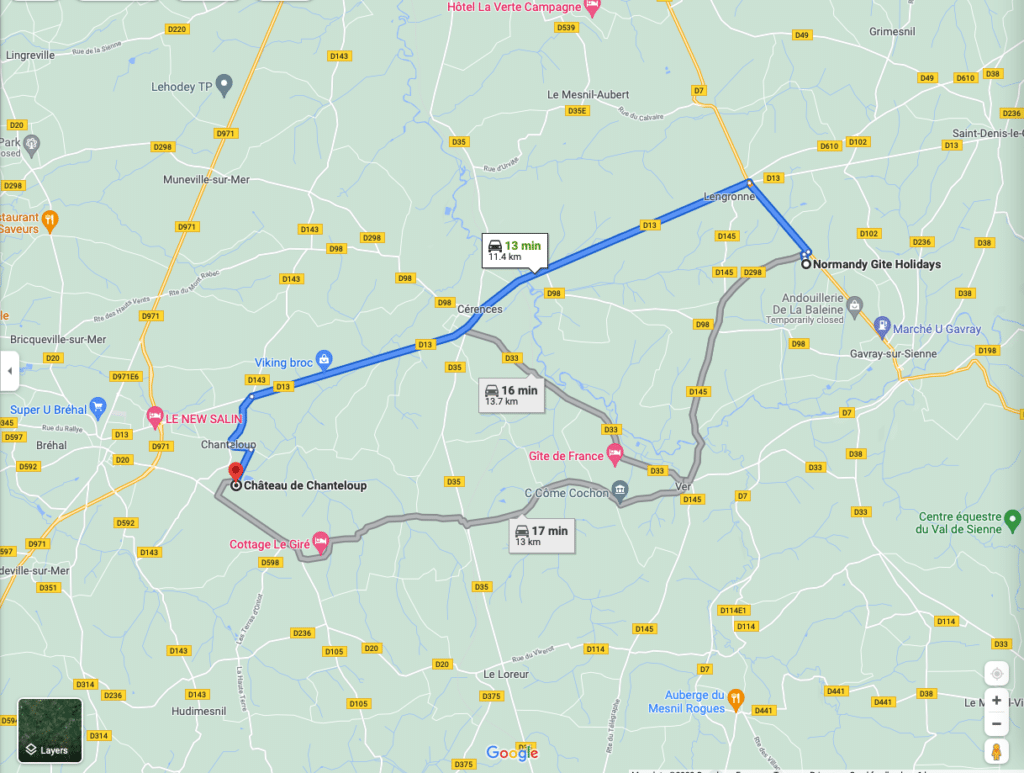
Notes
The farm shop is open in the summer months from Monday to Saturday inclusive from 10am – 12 noon and 2 – 6pm. Out of season it’s open on Thursday, Friday and Saturday afternoons. The chateau is just outside the village of Chanteloup in a tranquil setting. If you approach it from the D20, don’t follow the signs into the village.
3. Visit Mont Saint Michel

Mont Saint Michel is Normandy’s most popular tourist attraction and France’s second most popular. Only the Eiffel Tower in Paris receives more visitors. While both are on many tourists’ bucket list, the two couldn’t be any more different.
The island village is dominated by the 13th century gothic abbey that is its crowning glory. A previous version of the abbey dated from the 11th century but was destroyed by fire. Ramparts, towers and courtyards were added or strengthen to fortify the island in the 14th century. During WW2 it was used as a base for German troops and was liberated on 1 August 1944.
This remarkable video was taken on 24 April 2020 during France’s first pandemic lockdown. The photographer had to get special permission to film due to the strict travel restrictions in place. Understandably, the island is deserted and the only people the photographer saw were the nuns who live in the abbey. You see the approach to the island and the main entrance leading to the courtyard where La Mère Poulard make their famous omelettes. You then follow the narrowed cobbled main street which is lined with restaurants, bars and shops. Finally, you will see the abbey towering above as the photographer reaches the top of the island.

Directions
How to get to Mont Saint Michel

Notes
Contact Details
The address is Abbaye du Mont-Saint-Michel, 50170 Le Mont-Saint-Michel and they can be contacted on +33 (0)2 33 89 80 00. Once you’re nearby it’s difficult to miss it as you can see it looming in the distance. You can wander round the island at any time exploring the narrow streets and ramparts. You’ll get great views of the surrounding bay from the towers and ramparts and be able to see the outside of the abbey.
Opening Hours
The abbey is open from 9am to 7pm from May to August. From September to April it’s open from 9.30am to 6pm. The abbey is closed on 1st January, 1st May and also 25th December. During the summer months opening hours are often extended into late evening so its worth checking whether this applies when you want to visit.
Further Information
Children under 18 go free but need to show photographic ID. Students from EU countries aged 18 – 25 also go free with photo ID and evidence of where they’re studying. If you have a Brittany Ferries boarding card the adult rate is reduced. Booking needs to be made online. Visit the Mont Saint Michel abbey website.
Hints and tips
There is a link below including information including the best time to go, parking, tide times and visiting the abbey.
4. Spend Time At A Normandy Beach

Normandy beaches offer endless opportunities for fun such as swimming, sunbathing, paddling, playing beach games, kite flying and beach combing for shells. The coastline experiences very high and low tides so when the tide goes out there’s a lot of beach to enjoy.
One of my nearest beaches is at Coudeville-sur-Mer and it’s a mix of sand and shingle. You can walk from here to Saint-Martin de Bréhal via a pedestrian walkway that overlooks the beach. It’s very family friendly as kids can cycle or scooter along. It’s around 1km between the two resorts. There are a few more shops and restaurants in Saint-Martin. Saint-Martin is actually closer but it can be easier to park at Coudeville. Once you’re at Saint-Martin you can carry on walking for another kilometre to the sailing school.
The sailing school offers sailing, wind foiling, stand up paddling, canoeing, sand yachting and windsurfing. If lazing on the beach isn’t for you, then this might appeal. For something very different, how about fat biking on Omaha Beach as you can see in the video?

Directions
How to get to Coudeville-sur-Mer beach.
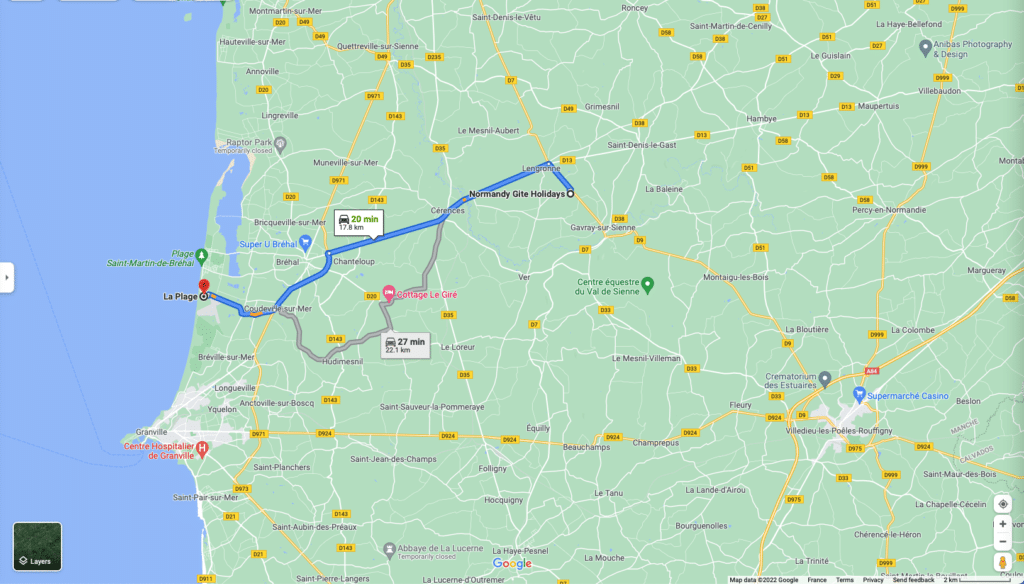
Notes
There are a few places to get food, drink and ice creams at the far end of the car park at the Coudeville beach. There are also public toilets at the lifeguard station. During the summer the beach is patrolled by lifeguards. As there’s a jetty here, buoys indicate two sections, one is for swimming and the other is for boats etc. This beach doesn’t allow you to take dogs onto it during the summer months. However, dogs can go on the pedestrian walkway. Most French families disappear from the beach at 12 noon and return after 2pm having had lunch.
5. Walk In William The Conqueror’s Footsteps

William was born in Falaise in Normandy in 1027 and became the Duke of Normandy in 1035. He became William I, King of England in 1066 after the Battle of Hastings. Due to the invasion, he was also known as William the Conqueror. He died in Rouen in 1087.
Caen held a special place for William as he built a castle here in around 1060. In addition he commissioned an abbey in Caen known as l’abbaye aux hommes. He chose to be buried in Caen in the abbey church, a majestic building worthy of his status.
The castle is known as the Château de Caen and it’s right in the centre of the city. Although you can visit it there is very little that remains from the palace that William built. One of the largest buildings is the Exchequer Hall built by Henry I who was William’s son. Next to it are the remains of the the three buildings that made up the original castle which were the hall, the chapel and the royal apartments. Subsequent additions in the centuries that followed were the church, governor’s mansion, the ramparts, towers and gatehouses, a donjon and barbicans.
There are two museums in the grounds of the castle; the Museum of Normandy and the Caen Fine Arts Museum.
The video shows the castle, the Men’s Abbey (abbaye aux hommes) and also the Ladies’ Abbey commissioned by William’s wife, Matilda.

Directions
How to get to Caen.

Notes
The castle grounds are usually open until dusk. If you want to visit either of the two museums, you buy tickets at the information desk in the church in the centre of the castle. Saint-Georges church is open from 9.30am – 12.30pm and 1.30 – 6pm on weekdays. At the weekend and public holidays it’s open from 11am to 6pm. From June to September it’s open every day and closed on Mondays outside of these dates. It’s closed 1st January, 1st May, Ascension Day in May, 1st November and 25th December.
How to find the castle
The castle doesn’t have an address as such. You can park near to the castle in the underground Parking Indigo Caen Château on Avenue de la Libération. Up to 3 hours will cost 4,80€. There is free parking within the chateau grounds that you can access via Boulevard de la Paix. On foot, the entrance to the chateau is on rue Monitoir Poissonnerie opposite the imposing Saint-Pierre church.
You can also walk along some of the ramparts and this gives you great views over the city. The skyline is dotted with numerous church spires including those of William’s abbey.
6. Free Things To Do In Normandy

A holiday in Normandy doesn’t have to be expensive as there are plenty of free things to do all year round. The majority of them are outdoor activities so will be dependent on the weather.
A great free activity that you can enjoy in Normandy is walking. This could involve putting your hiking boots on or something more leisurely. Whichever style suits you, then there are plenty of walks to choose from. Coutances Tourist office has produced a number of information leaflets detailing countryside and coastal walks and hikes. Other tourist offices will have similar information.
For a more relaxed style of walking, you could try a town or city walk. If you ask at a tourist office they may have a map of a circular route with key points to look out for. You can break up your walk or stroll by stopping for coffee or even lunch. In towns and cities, churches and cathedrals are generally free to visit and can be incorporated into your walk.
You can learn all about the history of Villedieu-les-Poêles, a town famous for the manufacture of copper items. Other artisans produced leather, lace and church bells. The artisans lived and worked in courtyards that are on either side of the Main Street. A total of 35 courtyards exist and they’re shown on a leaflet you can collect from the tourist office. There are a couple of shops selling copper pots and pans so you can also browse here for free.
The first 8 minutes of the video shows the town. You see some brown and orange boards in the video that highlight important buildings and sites. The courtyards also feature in it as do some of the copper shops.

Directions
How to get to Villedieu-les-Poêles

Notes
Tuesday and Friday mornings are market days in Villedieu. The Tuesday market is the biggest of the two so some of the car parks near the tourist office are taken up by stalls on that day. You may have to park a little further away from the centre of the town if the market is on but browsing in a market is another great free activity. If you did want to splash some cash on a copper pan, then the Mauviel shop on the outskirts of town is the place to go. They’re at 47 Route de Caen in Villedieu and are closed on Wednesdays, Saturdays and Sundays and between 12.30 – 1.30pm for lunch. You can find out more about Villedieu on the Villedieu-les Poêles Tourist Office website.
7. Enjoy Some Family-Friendly Fun Activities

Normandy is very family friendly and caters for children of all ages. One of the more unusual activities is the Ludiver Planetarium in the north of the Cotentin Peninsula. Here families can enjoy learning about the stars and the planets in the museum and planetarium. Sessions in the planetarium last around 45 – 60 minutes and need to be booked in advance.
Another unusual activity is the vélorail which is rail biking. Each bike takes a maximum of 4 adults or 2 adults and 3 children. There are two bikes to pedal and there are seats for the other passengers. The route uses a disused railway track that runs alongside the river Vire. It takes about 90 minutes to do the return trip which is 11km in total.
Depending on the age of your children there are soft play centres, crazy golf courses and adventure parks in Normandy. For the more adventurous why not try a theme park or even bungee jumping.

Directions
How to get to the Ludiver Planetarium

Notes
Planetérium Ludiver is at 1700, rue de la libération, 50460 LA HAGUE. Call 02.33.78.13.80 to book a session in the planetarium. Times are subject to change so ask when you book. The planetarium is closed on 1st January, 1st May, 1st November, 11 November and 25th December. During the summer months it’s open weekdays from 10.30am to 6.30pm. Children under 3 aren’t permitted in the planetarium but can go in the museum. Children under 7 go free for visits to the museum and planetarium. Adults pay 8,80€ for a museum and planetarium visit or 4,60€ for the museum only.
The Vélorail is at Rue de la Gare, 50890 CONDE SUR VIRE. Phone 02 33 05 46 55, Mobile 07 86 47 02 92. A bike costs 20€. During July and August it’s open every day. In April, May, June and September it’s open at weekends only. Find out more at the Normandy Tourist Office website.
8. Take A Day Trip From Normandy

A day trip to Honfleur is very popular with tourists. The coastal town is picturesque with colourful half timbered houses and narrow streets. The old harbour is in the centre of the town and was originally used as a trading port. Nowadays it’s a marina surrounded by tall and narrow townhouses. There’s a mix of slate and half timbered façades that have been converted into bars, restaurants or boutiques. The bars and restaurants have outdoor seating overlooking the harbour and their canopies and awnings add pops of colour.
Eugène Boudin who was Monet’s mentor painted here and you can visit the museum to discover more about him and Impressionism. The harbour is still popular with artists today and you’ll often find them painting this view or perhaps the fairground carousel on its east side.
Sainte-Catherine’s church is France’s oldest church made entirely of wood. It was re-built in the 15th century and replaced a stone structure. It’s located to the north of the harbour. Look for rue Haute near here as it’s very pretty. There are shops and restaurants at the harbour end but carry on and you’ll walk past centuries-old half timbered houses.
Other day trips to consider are to Rouen or the Pays d’Auge that straddles the Calvados and Orne departments. Near to Honfleur are the towns of Deauville and Trouville which are also suitable for a day trip. Suggestions for days out beyond Normandy include Paris by train, St Malo in Brittany, Jersey or the Chausey islands.
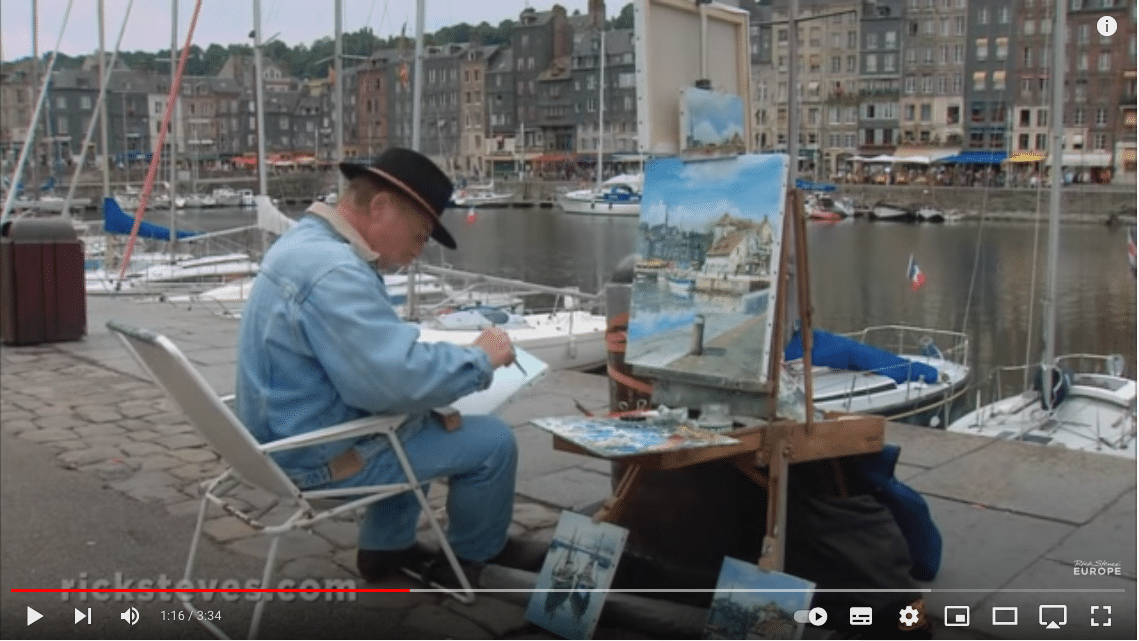
Directions
How to get to Honfleur in the Calvados department of Normandy.

Notes
The Musée Eugène Boudin is on Rue de l’Homme de Bois, 14600 Honfleur. Telephone 02 31 89 54 00.
The museum is closed on Tuesdays throughout the year and also 1st May, 14th July, 25th December and all of January.
It’s open from April to June from 10am – 12 noon and 2 – 6pm. From October through to March it closes half an hour earlier at 5.30pm. In July and August it remains open over the lunchtime period. It costs 6,50€ – 8€ during peak season and 4,50€ – 6€ at other times. Audio guides are available in English.
9. Visit A Normandy Château
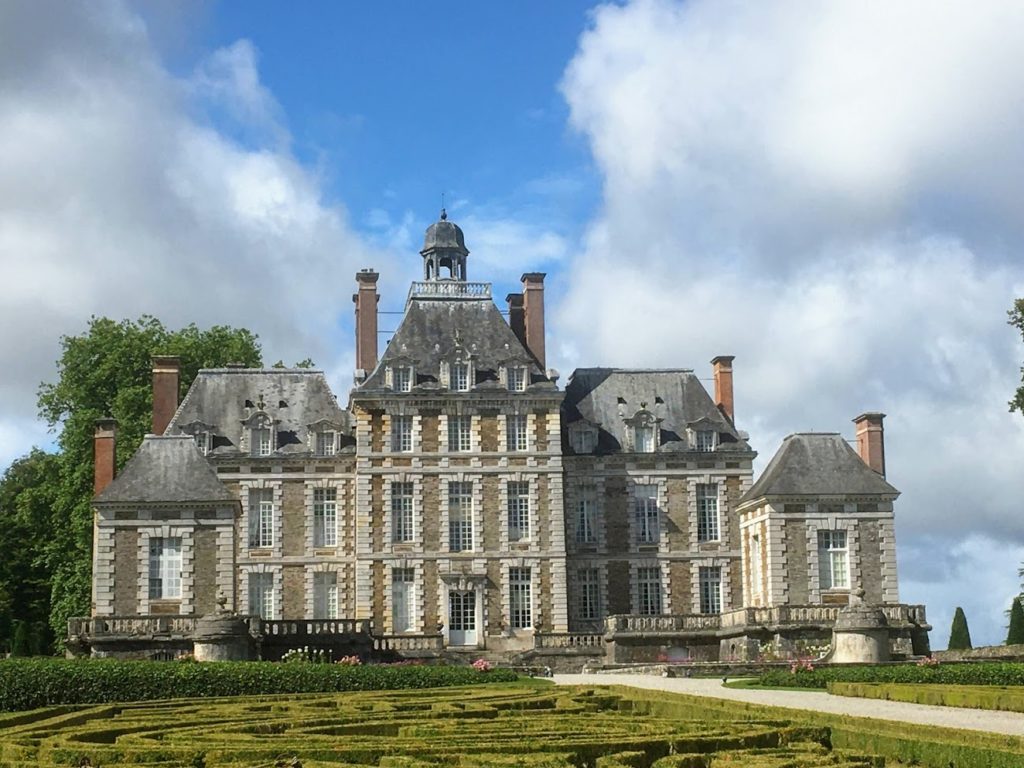
The Château de Balleroy was built in 1631 and incorporated an optical illusion to make the chateau appear bigger. Two square structures were added that are set forward from the castle. There is a long straight drive leading to the château so it works well.
However, the château isn’t small as you can see three floors plus an attic level. There are also kitchens and servants quarters below. It was owned by Malcom Forbes, the American entrepreneur and publisher, until his death in 1990. He was a hot air balloon enthusiast and there’s a museum about his passion in one of the former stables.
You can take a guided tour and start in the servant’s entrance. The huge room known as the salon Louis XIII was the original entrance to the chateau as it looks out onto the surrounding park. A key feature is the carved wooden ceiling. Just along the corridor is the smoking room and the dining room. The smoking room would have been where gentlemen retired to after dining and features a hot air ballon painted on the ceiling.
You get to see a number of bedrooms and also a bathroom on the next part of the tour. This bedroom wing would have been used for guests and there are numerous photos of famous people that either stayed here or on the Forbes’ yacht.
The final part of the tour includes a very large room known as the salon d’honneur. Guest receptions would have been held in this ornately decorated room with a four seasons painted ceiling. Finally, you get to visit Malcome Forbes’ study and library. It’s fascinating to see these elegant rooms with their ornate decor, panelling, sumptuous window treatments and decorated ceilings.
The video below shows 10 of Normandy’s best castles.

Directions
How to get to the château Balleroy.

Notes
Château de Balleroy, rue du sapin 14490 Balleroy. Telephone 02 31 21 06 76
The castle is open on Wednesdays through to Sundays in April, May, June, September and the French October school holidays from 10.45am – 6pm. The same opening hours apply during July and August but it’s open 7 days a week.
There are different pricing options depending on whether you visit the château, the park or the museum. Château visits will take place at least every hour from 11am to 5.15pm for the last one. The cost for all three activities is 9€ for adults and 6,5€ for children. The château can only be visited as a guided tour. Numbers for each tour are limited so it’s recommended that you book in advance.
Parking is available on Place du Château just off the roundabout in the centre of Balleroy. Alternative parking can be found near the roundabout.
10. Discover The Normandy Landing Beaches
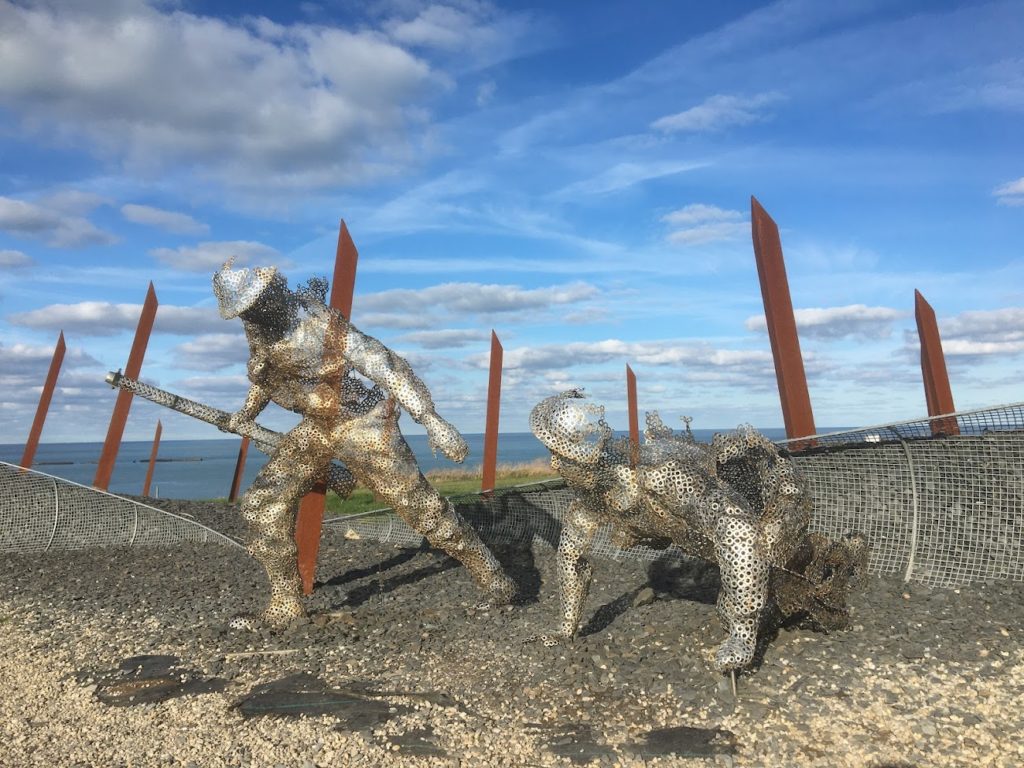
The video below takes you on a whistle stop tour of the five Normandy landing beaches where Allied troop landed on D-Day. You will see some of the museums and memorials on Utah, Omaha, Gold, Juno and Sword beaches as well as the actual beaches themselves.
A few cemeteries are included such as the British Cemetery in Bayeux, the German cemetery in La Cambe and the Normandy American Cemetery and Memorial. The later is in Colleville-sur-Mer and is the largest cemetery in Normandy for WW2 fatalities.
Also featured is Pegasus Bridge and the church in Sainte-Mère-Église that has a model of a paratrooper dangling from the steeple.
There are so many more sights to see including the amazing British Normandy Memorial that was opened in June 2021. The information below will help you to plan which places you want to visit. There are more videos and photos included in the links.

Directions
How to get to the D-Day 75 Garden

Notes
The D-Day 75 Garden is on rue du Calvaire in Arromanches and is free to visit at any time and is very near to the 360° Cinema. There is a car park here that costs 4€ for a car. If you’re only stopping for a short time to look at the sculptures, you could park in Arromanches itself and take the path up the hill. There is some free parking on rue Charles Laurent.
The D-Day sites link below is split into sections for each of the five beaches. There’s a separate article for each beach.







That’s a lovely and informative read Chris. It’ll be really helpful to your guests